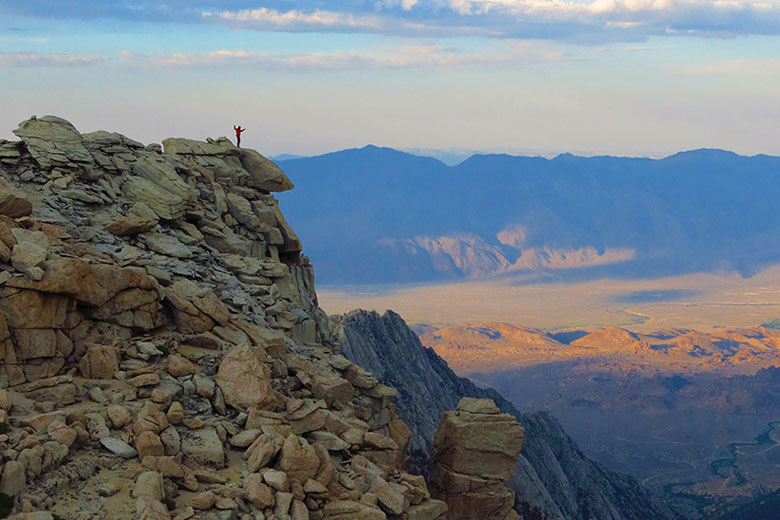Stanford scientists crack mystery of the Sierra Nevada's age
Recent research by Stanford Earth scientists uses new techniques to shed light on the contentious history of California's iconic mountain range.

Stanford Earth alum Hari Mix stands high in the Sierra Nevada. New evidence shows the California mountain range is 40 million years old, much older than previously thought. (Image credit: Hari Mix)
In science, the simplest questions often prove themselves the most difficult to answer. Questions such as what killed the dinosaurs, or how many fish are there in the oceans took decades to solve or remain unanswered.
One of the biggest questions in the geological history of the western United States is: How old is California’s Sierra Nevada? Recent work by a team including Stanford scientists goes a long way to providing an answer, as well as a view into climate history that could assist future climate change projects.
The research, available online at GSA Bulletin, used advanced geochemical techniques to investigate three key aspects of the Sierra Nevada history: age, elevation and climate.
“Understanding surface elevation is extraordinarily important because it is the physical representation of the balance between deep-Earth processes, such as mantle convection and plate tectonics, and surface processes, such as erosion, the water cycle and climate,” said Hari Mix, who began the research as a graduate student at Stanford School of Earth, Energy & Environmental Sciences.
“The age of the Sierras is a fundamental question in geology,” said Page Chamberlain, a professor of Earth system science at Stanford and co-author on the study. “It’s one of the largest mountain belts in the world, and it influences all western climate, so understanding the elevation history couples to all these different fields of research.”
Older than previously thought
The debate surrounding the age of the Sierra Nevada goes back decades. For much of that time, scientists believed that the mountains were relatively young, experiencing the majority of their uplift as recently as 3 million to 5 million years ago. A number of recent studies have called that age into question, however, specifically an influential study by Stanford researchers published in 2006 in Science that suggested that the Sierra Nevada reached their current elevation roughly 40 million years ago.
The team, including Page, fellow Stanford Professor Stephan Graham and postdoctoral student Andreas Mulch, analyzed different forms of hydrogen trapped in clay minerals that were exhumed and mined during the California Gold Rush. That work involved a technique called hydrogen isotope paleoaltimetry, which quantifies the types of hydrogen atoms in a rock sample to interpret its age and elevation. Since that 2006 report, some scientists have suggested that some of the hydrogen isotopes had exchanged with modern water, obscuring the true age of the range’s uplift.
To confirm the previous work, and to expand on its results, Mix and his colleagues used the same samples as those used by Mulch, but analyzed oxygen instead of hydrogen.
“Oxygen isotopes are more resistant to exchange and alteration than hydrogen isotopes, so our record of the Sierra Nevada uplift is more robust than previous studies,” said Mix, who is now an assistant professor at Santa Clara University.
“The preponderance of evidence that the Northern Sierras were high since 40 million years ago is just crushingly definitive,” said Chamberlain.
Mountain evolution through rainfall
To accurately determine the age of the Sierra Nevada, the team needed to understand how high the mountains stood 40 million years ago. Previous attempts to directly measure historical surface elevation have provided only aspects of the range’s history, but the Stanford team’s approach made it possible.
By analyzing the oxygen fingerprint within the clay minerals, Mix and his colleagues were able to uncover long-term historical rainfall patterns and determine if they matched those expected from high mountain ranges. They found that the signal was consistent with the high Sierra tens of millions of years ago, indicating that the range was already uplifted at this time.
By coupling the Sierra’s elevation history with knowledge of the climate system and deep-Earth processes, this team’s work can help scientists determine which processes might have been most important in shaping the world into what we see today.
Implications for today
According to Mix’s study, the Sierra Nevada formed roughly 40 million years ago, a time geologists refer to as the Eocene. The Eocene was the most recent time in Earth’s history when carbon dioxide levels were higher than they are today, and many scientists view this as the worst-case scenario analog for today’s anthropogenic climate change.
By combining the hydrogen isotope record with the oxygen isotope record, Mix and his colleagues were able to effectively create a thermometer, and their findings suggest that the Sierra formed under very different climate conditions than today.
“The temperatures that we determined by combining the hydrogen and oxygen records are 18 to 27 degrees Fahrenheit [10-15 C] hotter than the modern Northern Sierra,” Mix said.
The high temperatures inferred from the hydrogen and oxygen fingerprints are consistent with other estimates of Eocene climate based on analysis of leaf fossils, other minerals, and climate models. This new analysis has the added benefit of aiding climate scientists who investigate today’s planet. Scientists test their models against ancient climates, for which a lot of data are available.
“Climate modelers use the elevation and temperature reconstructions like those we investigated as boundary conditions for their models,” Mix said. “Hopefully, these new and improved constraints will help modelers test the many ways in which different components of the Earth system interact with one another, and give us better information about today’s planet as well.”
